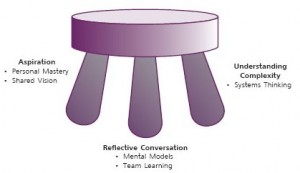Recently, I had the honor to speak on my favorite subject, “Systems Thinking,” during a fascinating event on “Learning Organizations and the New Leadership Model.”
In a short time it became apparent that there is little common ground among businesspeople on the meaning of “learning” or “a learning organization.” This is perplexing. I would expect that under current circumstances, which most of us identify as a “crisis, “ and under the pressure of an ever-accelerating rate of change, “learning” would have been identified as the key weapon to fight this war, as well as most of the battles that we face.

Core Learning Capabilities of Learning Organizations by Peter Senge
We know, from our early years, that through learning we become better, stronger, healthier, and happier. It is through learning that we increase our range of influence; we become more responsible, more complete. And through learning we progress, we advance and, if all goes well, we excel.
Oddly, when it comes to our business life, learning takes on a more dry and academic sense. Furthermore, by and large, it becomes only accessible to higher-level executives, for whom it is manifest mostly in the form of occasional, obligatory seminars and workshops. The rest of the company does “training,” a nice word for the often one-way, brainwashing practice on procedures, based on compliance and not choice. In other words, “butter on the bread” of analytical thinking… hence the dead-end.
Systems such as our society, our businesses, or our families are based on constant feedback for continual transformation and improvement. And this precious and vital feedback—let’s call it “Learning Part 1”— must be sought from any and all sources and by any and all system parts. This is especially true, for instance, in engaging employees who interact on a daily basis with our customers, such as shop-floor employees.
Integral to the quest for feedback, but hidden, is the notion of a mental model which filters distortion from the environment, reduces noise and unnecessary variety. We need only valuable feedback to make fast wise choices.
But value to the business system comes only through the filter of the shared “lenses” of a common vision, so unless we ensure that we are all “on the same page” we cannot trust the feedback we get. And we need bi-directional open communication to receive the feedback, and “advance” it to higher levels where it should be transformed into corrective measures and strategic decisions and returned
Real learning must be based on valuable, filtered feedback, gathered from all parts of the system, processed, and turned into actions. It can be effective and productive only if done by choice and as part of a larger and widely shared business culture. And this is where we usually fail…
Getting an organization to the learning mode is no easy task that needs honest, cross-layer communication. This communication initiates a feedback loop so management may re-assess strategy and positioning, take corrective measures, fine-tune procedures and redirect all these to everyone in the company. It, in turn, generates new feedback, spreads values throughout the company and establishes a renewed, shared vision. This we can call “Learning—Part 2” and it is this that provides the people of the company with effective weapons and behaviors with which to fight the war.
Systems are based on relationships and interaction between parts. Respect and trust are “sine quibus non.” To start to really learn we really need to respect the existence of all system parts, their true value added, and trust their feedback. To do that, we must break new ground in the way we think and change our mental model, both in the executive office and on the shop floor.
Article by Alexander Athanassoulas, Business Partners magazine [December 2010]

